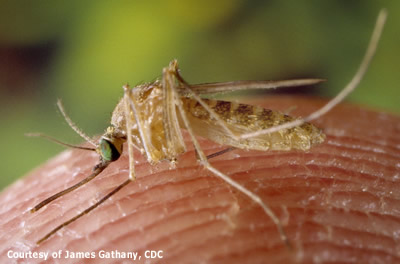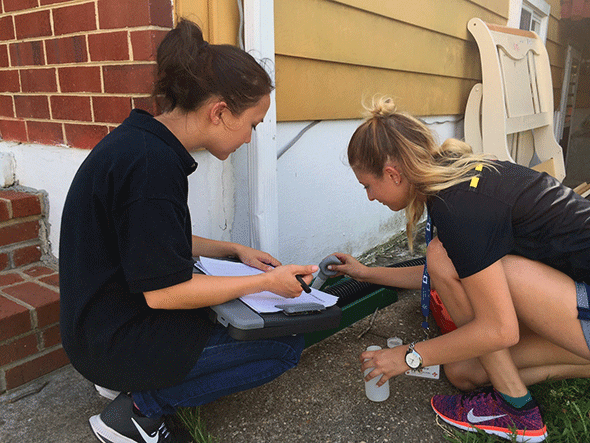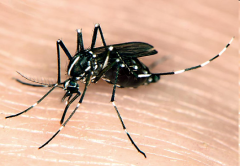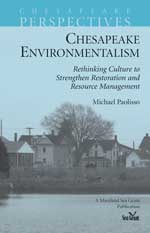Knauss legislative fellowships in Congress help build careers — and they're fun and educational. See our video and fact sheet for details.
Buzz and Slap: Does Backyard Stormwater Management Bring Unwelcome Visitors?
“Do you mind if we check your rain gutters for mosquitoes?” was a phrase that my field crew and I used a lot this summer. Our research took us door to door in the Petworth neighborhood in the District of Columbia and in Bladensburg and Columbia in Maryland. We wanted to ask residents what they knew about controlling mosquitoes in their yards.
We were also interested in surveying stormwater management structures, including rain gutters, rain barrels, and corrugated disconnected gutters, to see if they actually may harbor mosquitoes. These structures can sometimes allow standing water to form where mosquitoes can breed, and if not regularly managed, may promote mosquito infestation. Because our study areas are within the Chesapeake Bay watershed, the ultimate goal of my research project was to see if mosquito breeding was linked to efforts to reduce stormwater pollution in the Bay.
My field crew consisted of myself and three undergraduate research assistants, Michael Littleford, Amy Milne, and Hannah Spates, from Dr. Paul Leisnham’s Ecosystem Health Lab at the University of Maryland, College Park. To gather data, we went in pairs and asked residents to complete a detailed questionnaire about mosquitoes.
We followed up by collecting mosquito larvae from any water-holding containers on their property. In addition to rain gardens, these containers can include birdbaths, gardening buckets, and trash cans. Our goal was to see if the knowledge and behaviors of residents affected the numbers of mosquitoes growing within their backyards. We also wanted to know if stormwater management structures contained more mosquitoes than other types of habitats.
Our research project is relevant because many groups across the Chesapeake Bay are encouraging homeowners to install stormwater management structures in their yards. But they present trade-offs. On the one hand, we want to encourage wider use of these controls because they help reduce nutrient pollution in the Chesapeake Bay – they force stormwater to drain down into the soil in yards rather than rush down driveways and roads and eventually into local waterways and the Bay.
 |
|
Albo albopictus mosquitoes are pests and disease vectors in Maryland and Washington, D.C. Credit: James Gathany, U.S. Centers for Disease Control and Prevention |
But on the other hand, we want to ensure that stormwater management structures do not promote high numbers of mosquitoes. These insects are not only a nuisance but also a public health hazard. The Aedes and Culex species of mosquitoes that breed in yard containers are common biting pests and can transmit a range of viruses, including West Nile virus. The most common Aedes species, the Asian tiger mosquito, can also transmit Zika virus, which is linked to severe birth defects and has recently been introduced into the continental United States.
Before starting my master’s degree at the University of Maryland, I studied both anthropology and wildlife ecology at the University of Florida and became interested in the interactions between people and the environment. Through my fieldwork, I’ve been able to use my multidisciplinary background to administer in-depth questionnaires to query residents about their interest in managing both mosquitoes and stormwater.
I am still analyzing my data, but have found some interesting findings already. For instance, an interesting trend seems to be that although some residents were highly concerned about mosquitoes, they still had little knowledge of mosquito-borne diseases found in the area. Another finding is that while many households’ stormwater structures were breeding mosquitoes, the total number of mosquitoes breeding in these containers seemed lower overall than the number found in other types of yard containers, such as trash cans or flower pots.
Being able to gauge people’s fear of mosquitoes and then compare it with the actions they take in their yards to control mosquitoes has been by far the most interesting part of this research. People listed hairspray, fabric softener sheets, and even a pet turtle as mosquito-control methods! And while some residents insisted that these were effective solutions, I couldn’t help but wonder why they did not try harder to prevent mosquitoes from breeding in their yard in the first place.
 |
|
Hannah Spates (right) and I sample a disconnected downspout. Many disconnected downspouts have corrugated extension spouts (as shown) that can hold water that provides the development site for many mosquitoes. Photo by Dr. Paul Leisnham |
The good news is that there are easy ways for homeowners to make sure that rain barrels, disconnected downspouts, and other water-holding containers are mosquito-free:
- Residents can add Bacillus thuringiensis israelensis (Bti), often sold under the name Mosquito Dunks. Bti is a naturally occurring soil bacteria that is used in mosquito control. It is ingested by the feeding larvae. Mosquito Dunks are labeled for use in animal watering troughs, birdbaths, rain barrels, and roof gutters.
- Residents should also ensure that all openings on a rain barrel are covered with screening material.
- Residents can cut small holes down the length of the plastic drainage pipes that are often connected to the ends of gutter spouts. The holes facilitate drainage from the tubes and minimize standing water.
Pointing out the importance of stormwater structures in managing nonpoint source pollution and the need for effective mosquito management in rain barrels and disconnected gutters was a satisfying extension component of my work this summer!
Photo, top left: Asian tiger mosquito (Ades albopictus). Credit: Susan Ellis, Bugwood.org, licensed under a Creative Commons Attribution 3.0 License.
See all posts to the Fellowship Experiences blog




